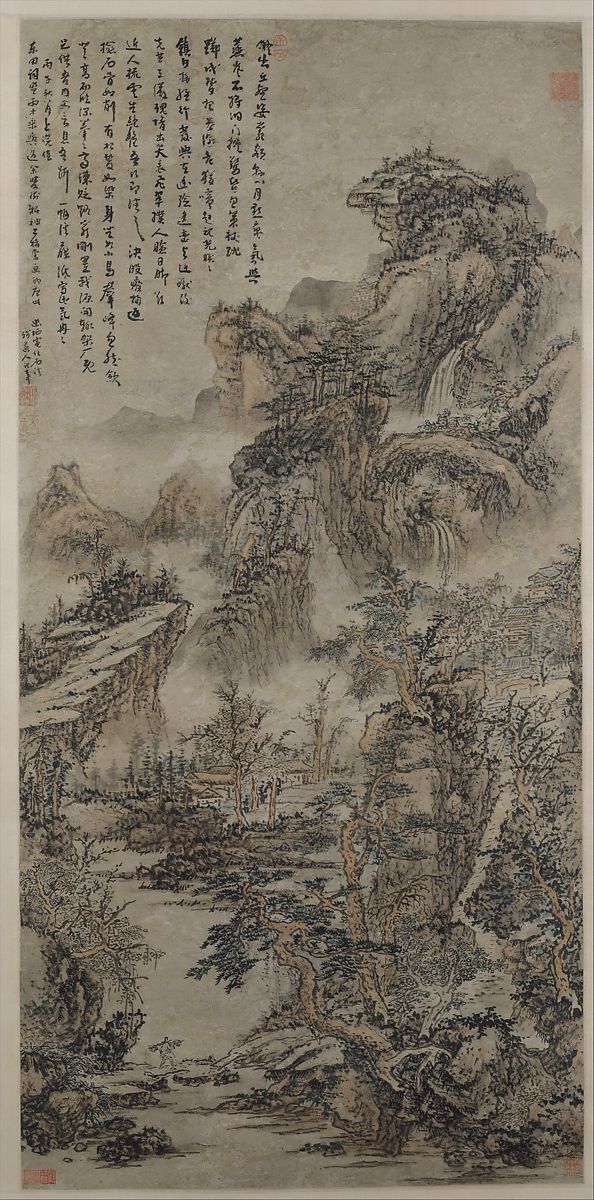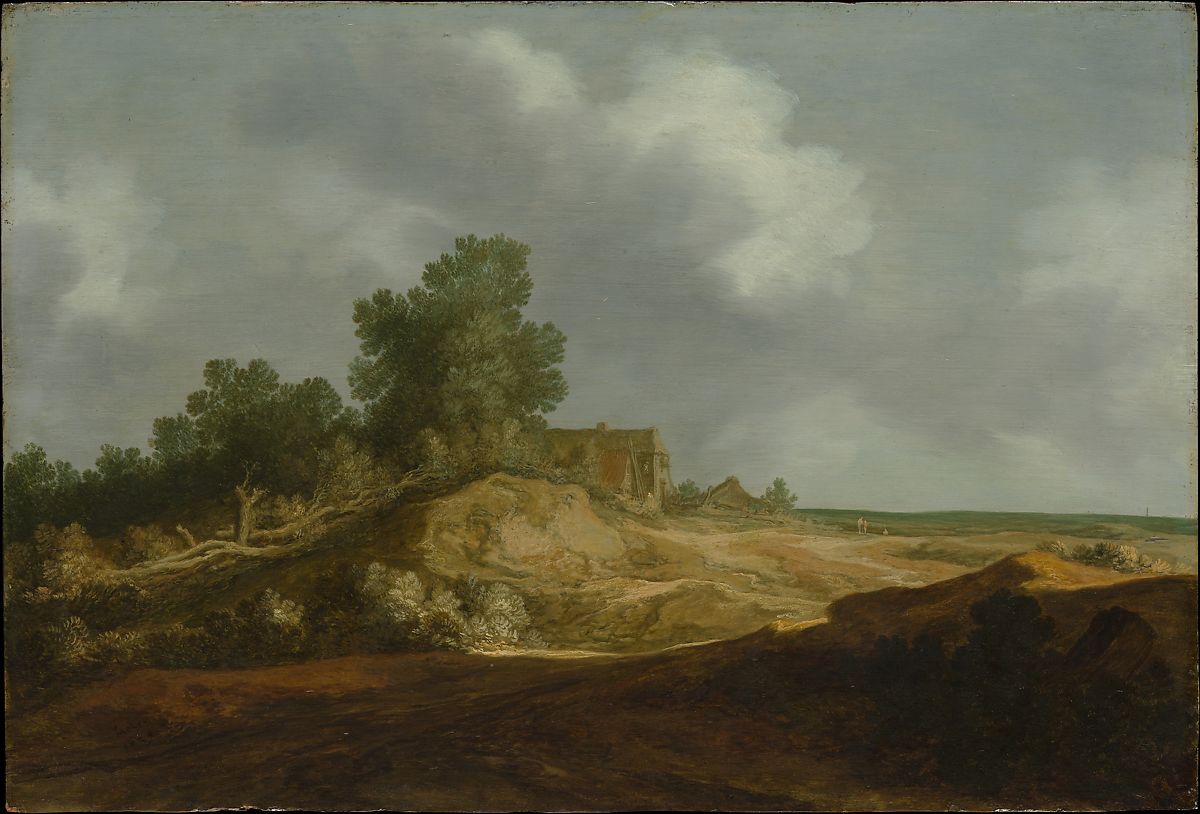Introduction


Two pictures that highlight the philosophical meanings of Eastern and Western landscapes and their ideals and aesthetic qualities are Landscape with a Cottage by Pieter de Molijn and Wooded Mountains at Dusk by Kuncan. The first was painted in 1629, while the latter was dated around 1666, which indicates the same time of creation. Pieter de Molijn depicts the modest scene of the countryside with a small mound, vast spaces, thick, slightly blue clouds, and lonely companions in the background. Simultaneously, Kuncan presents the personal impressions of Yellow Mountain, visited in 1659, encircled by woods and rocks. The core differences between Eastern and Western landscape paintings comprise the aesthetic quality of the works, the choice of scene, and underlying meaning.
Comparison
The primary difference between Western and Eastern landscape art revolves around their aesthetic qualities. In Chinese landscape paintings, the aesthetic foundation is the manifestation of personal perception of nature rather than simply rendering (Bao et al. 2). This manifestation is primarily conveyed in artists’ attitudes towards brushstrokes that are sparing and give paintings a minimalistic appearance. In Wooded Mountains at Dusk, minimalism is principally expressed via lacking reliance on light, shadow, and colors. In this regard, Kuncan tries to emphasize his feelings and emotions behind each brushstroke. Dynamic perspective gives the sense of movement or as though the artist wanders and contemplates in the forest and between rocks and hills
Western landscape artists are inclined to pay meticulous attention to the details of scenery, its colors, features, and moods that can be magnificent or calm. Moreover, they provide more technical brushstrokes to outline the shading and light of objects accurately (Smart Art). Indeed, in Landscape with a Cottage, all objects are clearly distinguished, and the shadow is distinctly separated from the light. Molijn’s picture is also less dynamic and looks more like a photograph.
In Kuncan’s painting, drawn in the dense texture, mist, clouds, and water is shown as light objects, whereas mountains and trees acquire a darker color. Branches and trees are mostly sharp, curved, and sinuous at some points, attracting viewers’ attention and acting as a focal point. In this regard, the Chinese artist deliberately creates a harmonious relationship with heaven, earth, and the wonders in his composition. In his painting Pieter de Molijn exaggerates nature’s objects, including a hill, trees, and clouds, and downplays people, thereby expressing the esteem for the countryside and emphasizing its distinct quality: tranquility.
Western landscape paintings apply techniques directed at unfolding the significance of nature but, at the same time, creating an accurate depiction. Thus, the Western landscape picture is more representational and bears the apparent traits of realism. In Landscape with a Cottage, Molijn aims at conveying the beauty of the duneland landscape during the period of growing national spirit and fight for independence from the Spanish. Herewith, the artist attempts to catch each remarkable detail, making the picture vivid indeed. This aligns with the idea that Western painters targeted transmitting the precise view of what they observe, with minor deviations from geometrically correct representation (Bao et al. 2). Besides, instead of typical bird’s-eye prospect on the scene, Molijn puts the spectator near the ground and in a shadow area, creating an impression of a real place, not imaginative.
On the other hand, Eastern landscapes do not try to present the exact appearance of a particular spot, but rather, they seek to covey personal feelings and thoughts evoked by a specific place. Da-Wei states that even white voids and spaces on the paper are indispensable elements of a painting and calligraphy and are meant to welcome and inspire viewers’ imagination (Culture Theory). Overall, like a majority of Chinese artists, Kuncan seizes the essence and spirit of the scene than its external traits.
Nevertheless, the most striking distinction between Western and Eastern landscape art is based on different worldviews. The Chinese fine art is formed under the influence of Chinese philosophical concepts, namely, Buddhism, Confucian, and Taoist. In particular, similar to like Confucianism, Taoist principles include simplicity, inaction, and harmonic living with the cosmos (Bao 6). This belief of connection between an individual and nature is explicitly displayed in Kuncan’s work, who states, “I feel like a small bird” in this place (The Met).
On the contrary, Western landscape artists are inclined to pay meticulous attention to the details of scenery, its colors, features, and moods that can be majestic or calm. Western paintings bear a noticeable imprint of its ancient and medieval culture cultivated by Christianity and Greek philosophy. From a Christian point of view, God is the spring of beauty, and thus, painters usually pursue to find the trace of divine majesty in the features of the naturalistic environment (Culture Theory). In this respect, Pieter de Molijn admires the countryside, expressing reverence for its virgin beauties and remarkable qualities, namely, peace, serenity, and genuine but humble power.
Conclusion
Altogether, Eastern and Western fine arts possess both shared traits and specific differences. Landscape with a Cottage and Wooded Mountains at Dusk both interact with viewers and engage them in the contemplation of the surrounding environment. In addition, these pictures are tightly connected with religious concepts, thereby conveying underlying messages about spirituality and traditions. However, their discrepancy is primarily exhibited in aesthetic qualities and worldview. Western art focuses on realism and accurate reproduction of nature and objects, while Eastern artists aim at transmitting their feeling and understanding via scenery depiction. Finally, Western landscapes have more technical brushstrokes and fixed perspectives, whereas Chinese painters use dynamic and minimalistic styles.
Work Cited
Bao, Yan, et al. “Aesthetic Preferences for Eastern and Western Traditional Visual Art: Identity Matters.” Frontiers in Psychology, vol. 7, 2016, p. 1596.
“Chinese and Western landscape painting.”Culture Theory. Web.
“Chinese Art vs. Western Art.”Smart Art, 2020, Web.
De Molijn, Pieter. Landscape with a Cottage. 1629. The Metropolitan Museum of Art, Web.
Kuncan. Wooded Mountains at Dusk. 1666. The Metropolitan Museum of Art, Web.